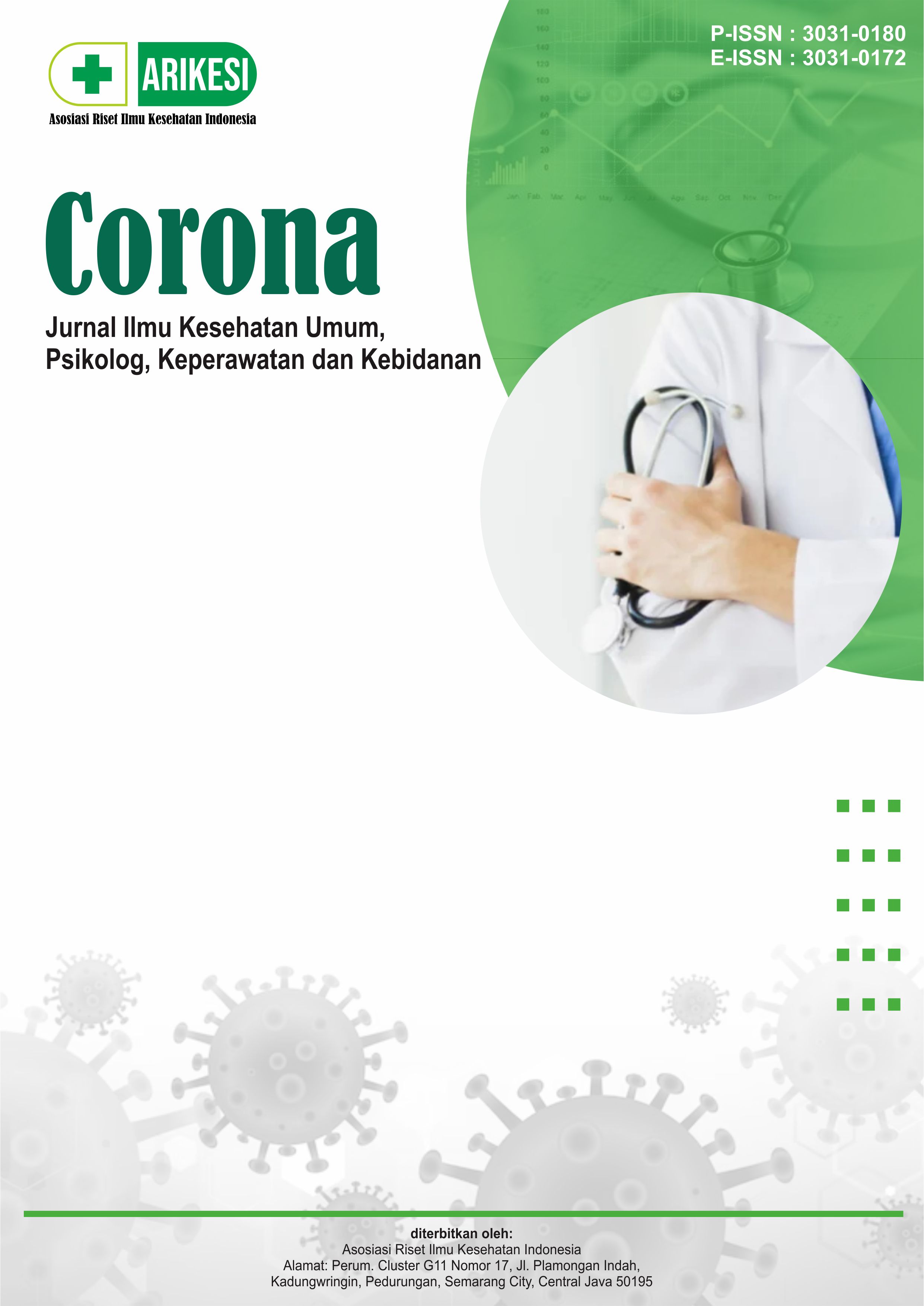Deteksi Kadar Amonia (NH3) pada Air Limbah Domestik di Rumah Makan Ajibarang Purwokerto
DOI:
https://doi.org/10.61132/corona.v1i2.662Keywords:
Ammonium, Environment, Nitrogen Cycle, PollutionAbstract
The catering industry is quickly expanding, especially among large cities, since there is high demand from consumers requiring fast, practical, and extensive meal services. The catering industry is growing at precisely the same rate as the community. Human activity in reaching its essential necessities will inevitably generate waste that might harm the environment, primarily liquid waste. Domestic wastewater consists of human waste produced through restrooms, laundry, kitchen equipment, and other domestic activities. Ammonia (NH3) is one of the most prevalent compounds found in wastewater. The amount of ammonia is also a critical variable to consider when establishing the level of safety of wastewater. The presence of ammonia beyond the threshold may harm the aquatic environment and other organisms due to its potential danger for almost all of them. Researchers would like to employ spectroscopic photometry to measure the ammonia (NH3) levels of domestic wastewater from reastaurants surrounding Ajibarang, Purwokerto. As stated in regulation of the Ministry of Environment and Forestry of Indonesia No. 68 of 2016, the concentration of ammonia in domestic wastewater fulfills the established domestic water quality standards.
Downloads
References
Afwa, R. S., Muskananfola, Rahman, M. R., Suryanti, A., & Sabdaningsih, A. (2021). Analysis of the load and status of organic matter pollution in Beringin River Semarang. Indonesian Journal of Chemical Science, 10(3), 168–178. https://doi.org/10.15294/IJCS.V10I3.50705.
Anggraini, L., Asih, A. Y. P., Andriansyah, A. A., & Afridah, W. (2022). Pemeriksaan kualitas limbah cair dengan parameter amonia bebas (NH3-N) dan fosfat (PO4). Human Care Journal, 7(3), 615-520. https://doi.org/10.32883/hcj.v7i3.1987.
Cahyani, F. A. (2020). Upaya peningkatan daya dukung lingkungan melalui penerapan prinsip sustainable development berdasarkan Undang-Undang Nomor 32 Tahun 2009 tentang Perlindungan dan Pengelolaan Lingkungan Hidup. Indonesia State Law Review, 2(2).
Gupta, V. K., Sadegh, H., Yari, M., Ghoshekandi, R. S., Maazinejad, B., & Chahardori, M. (2015). Removal of ammonium ions from wastewater: A short review in development of efficient methods. Global Journal of Environmental Science and Management, 1(2), 149-158. https://doi.org/10.7508/gjesm.2015.02.007.
Guthrie, S., Giles, S., Dunkerley, F., Tabaqchali, H., Harshfield, A., Loppolo, B., & Manville, C. (2018). The impact of ammonia emissions from agriculture on biodiversity. Cambridge: RAND Corporation.
Harahap, S. (2013). Pencemaran perairan akibat kadar amonia yang tinggi dari limbah cair industri tempe. Jurnal Akuatika, 4(2), 183–194.
Hibban, M., Rezagama, A., & Purwono, P. (2016). Studi penurunan konsentrasi amonia dalam limbah cair domestik dengan teknologi biofilter aerob media tubular plastik pada awal pengolahan. Jurnal Teknik Lingkungan, 5(1), 1–9.
Karri, R. R., Sahu, J. N., & Chimmiri, V. (2018). Critical review of abatement of ammonia from wastewater. Journal of Molecular Liquids, 261, 21-31. https://doi.org/10.1016/j.molliq.2018.03.120.
Mahyudin, Soemarno, & Prayogo, T. B. (2015). Analisis kualitas air dan strategi pengendalian pencemaran air Sungai Metro di Kota Kepanjen Kabupaten Malang. Jurnal Pembangunan dan Alam Lestari, 6(2), 105-114.
Ngibad, K. (2019). Penentuan konsentrasi ammonium dalam air Sungai Pelayaran Ngelom. Journal of Medical Laboratory Science Technology, 2(1), 1-6. https://doi.org/10.21070/medicra.v2i1.2071.
Pamungkas, M. T. O. A. (2016). Pencemaran limbah cair dengan parameter BOD5 dan pH di pasar ikan tradisional dan pasar modern di Kota Semarang. Jurnal Kesehatan Masyarakat, 4(2), 166–175.
Parvizishad, M., Dalvand, A., Mahvi, A. H., & Goodarzi, F. (2017). A review of adverse effects and benefit of nitrate and nitrite in drinking water and food on human health. Health Scope, 6(3), e14164. https://doi.org/10.5812/jhealthscope.14164.
Pujiastuti, P. (2018). Analisis air dan air limbah. Surakarta: UNS Press.
Radu, G., & Racoviteanu, G. (2021). Removing ammonium from water intended for human consumption: A review of existing technologies. IOP Conference Series: Earth and Environmental Science, 664, 1-10. https://doi.org/10.1088/1755-1315/664/1/012029.
Romsiah, R., Marista, S. L., & Fatoni, A. (2017). Validasi metode dan penetapan kadar nitrit (NO2-) pada sosis sapi curah dan sosis sapi kaleng yang dijual di swalayan Kota Palembang secara spektrofotometri UV-Vis. Scientia Journal of Pharmacy and Health, 7(2), 113–119.
Sasongko, A. (2018). Ammonia determination in bottled water using spectrophotometer: Comparison between Nessler and Berthelot methods. Jurnal Sains Dan Teknologi, 7(1), 126–134. https://doi.org/10.23887/jstundiksha.v7i1.13009.
Schaider, A., Rodgers, K. M., & Rudel, R. A. (2017). Review of organic wastewater compound concentrations and removal in onsite wastewater treatment systems. Environmental Science and Technology, 51(13), 7304–7317. https://doi.org/10.1021/acs.est.6b04778.
Sharma, S., & Bhattacarya, A. (2017). Drinking water contamination and treatment techniques. Applied Water Science, 7, 1043–1067. https://doi.org/10.1007/s13201-016-0455-7.
Soler, P. (2021). Improving water quality does not guarantee fish health: Effects of ammonia pollution on the behaviour of wild-caught pre-exposed fish. PLoS One, 16(8), e0243404. https://doi.org/10.1371/journal.pone.0243404.
Vries, W. (2021). Impacts of nitrogen emissions on ecosystems and human health: A mini review. Current Opinion in Environmental Science & Health, 21, 100249. https://doi.org/10.1016/j.coesh.2021.100249.
Winarta, R. C., & Kunto, Y. S. (2013). Pengaruh kualitas layanan Rumah Makan Bromo Asri terhadap kepuasan. Jurnal Manajemen Pemasaran, 1(1), 1-10.
Downloads
Published
How to Cite
Issue
Section
License
Copyright (c) 2023 Corona: Jurnal Ilmu Kesehatan Umum, Psikolog, Keperawatan dan Kebidanan

This work is licensed under a Creative Commons Attribution-ShareAlike 4.0 International License.





